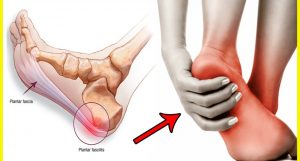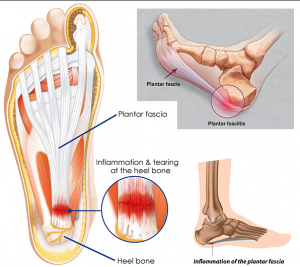Plantar fasciitis is caused by aseptic inflammation of the tendons or fascia of the plantar. The most common symptoms are heel pain and discomfort. The tenderness is often on the sole or near the heel. Sometimes the tenderness is severe and persistent. The pain is obvious when you wake up in the morning, and the pain is aggravated when you walk excessively. In severe cases, the pain is even when standing and resting. Plantar fasciitis is a chronic injury caused by exercise. Overtraining can also cause pain in the calcaneus, sometimes radiating to the front of the foot. This disease can affect adults of all ages.
The role of the plantar fascia:
The plantar fascia is a connective tissue that runs along the bottom of the foot, from the heel to the toe. This fascia helps maintain the integrity of the arch and has the function of shock absorption. In addition, it also plays a key role in the winch mechanism.

What is the winch mechanism:
The plantar fascia is located between the calcaneus and the metatarsal. It is a strong and generous fan-shaped elastic connective tissue. It can be divided into three parts in structure (Figure 1): The most obvious central part is attached to the proximal end. The medial tuberosity of the calcaneus is 1.5-2 cm wide, and it often contains the Achilles tendon and the end tissue of the plantar ligament; the distal end is tightly attached to the flexor digitorum Brevis. The proximal part of the lateral (or peroneal) part originates from the outer edge of the medial tuberosity, the distal lateral side is attached to the fifth toe metatarsal, and the medial side is fused with the fascia of the abductor minor phalanx. The medial (or tibial) part is quite thin and forms the covering fascia of the abductor major phalanx muscle, and the distal end joins the dorsal fascia of the foot.
During the walking cycle, the feet need to bear considerable pressure shocks. When the toe touches the ground, the force is 15-25% higher than when the heel touches the ground. Fortunately, the winch mechanism of the plantar fascia corresponds to it (Figure 2). When the heel is lifted, the toes show dorsiflexion at the metatarsophalangeal joint. This joint increases the tension of the fascia due to the weight to produce a twisting effect: draw closer the calcaneus and metatarsals, increase the curvature of the medial longitudinal arch, Put the metatarsophalangeal joint in an external rotation position, so that when advancing, the arch of the foot can be maintained stable, and it can also absorb the impact force caused by the bodyweight on the foot when it hits the ground like a shock absorber disk.
Cause of illness:
Due to the long-term effects of overload pressure, acute or chronic damage to the plantar fascia is the main cause of pain. The most common reason is that they often walk for long periods, including mountaineering, fitness, hiking, shopping, and other activities. Walking for a few days in a row can easily cause chronic damage to the soles of the feet, leading to plantar fasciitis. In addition, there are structural factors that cause abnormal tension of the plantar fascia, such as flat feet, high arch feet, and short heel tendons. In the long term, the waist, hips, knees, ankles, etc. may be caused by improper posture during walking.

External factors – shoes:
Many shoe designs directly bring abnormal tension to the plantar fascia and prevent the muscles of the foot from being used. Toe warp/toe height is most seven shoes, there will be an upward curve in the front area, this upward curve is called “Toe Spring”. Compared with the complex structure and function of the foot, the design of shoes appears crude. This curve creates a rocking motion, allowing the wearer to shift the weight from the heel to the forefoot. This rocking motion is designed to replace the motion of the sole when people walk barefoot, but in fact, the motion of the human foot cannot be replaced. With this design, when you are standing or walking wearing shoes, most of the time your toes are lifted and off the ground. Make the toes in an extended position, or a state of “back bending”. Because of this, the toes touch the ground only when the heel is raised. The “Toe Spring” design has done several main things:
- Maintain the plantar fascia and other structures under the sole in an unnatural elongated position.
- Obstruct the toes from grasping the ground.
- Obstruct the contraction of the muscles inside the soles that support the arch of the foot.
- Hinder muscles and plantar fascia assist shock absorption.
- It may cut off the blood circulation in the soles of the feet. Compared with walking in shoes, walking barefoot allows the toes to touch the ground and walk more smoothly. It can also assist in grasping the ground and provide stability to the arch of the foot. Without the support of the inner muscles, the plantar fascia will be in abnormal tension. This is a very bad situation because “Toe Spring” puts the plantar fascia in a stretched position. (Winch mechanism) And when the plantar fascia is already stretched, when the foot touches the ground, the shock absorption capacity will be limited. The increase in tension on the plantar fascia not only involves the restricted movement of the toes but also affects the internal muscles.
Symptoms:
The patient’s heel is painful when carrying weight, and the pain usually lasts for several months to several years, especially after waking up in the morning or after prolonged periods of inactivity. The most common symptoms of plantar fasciitis are heel pain and discomfort. Generally speaking, the pain is most obvious in the first step when getting out of bed in the morning. This is mainly because, after a night of rest, the plantar fascia no longer bears weight and will be in a relatively shortened state. Therefore, when getting out of bed in the morning and stepping on the ground, the plantar fascia will be stretched more quickly and cause pain. But after walking for a while, the plantar fascia will become looser, so the symptoms will be relieved. However, if you walk excessively, the plantar fascia is stretched more often and the symptoms will reappear. The tenderness point is often near the heel of the plantar, and sometimes the tenderness is severe and persistent. The resulting pain is characterized by pulsation, burning, and tingling.
Inflammation is not true inflammation:
“Fascial tightness” is the cause of plantar fasciitis. A few are caused by bone spurs. The formation of bone spurs is also due to long-term fascia tightness. The connected bones are under tension for a long time, and bone spurs will grow from the bones. The “disease name” of plantar fasciitis is mistaken for inflammation, but it is caused by tightness of the fascia, so relaxing the fascia is the best treatment.

Treatment:
- Physical therapy: rest and use physical therapy to improve heel pain, including ultrashort wave, electrotherapy, etc. For heel pain caused by standing or exercising for a long time, apply ice on the heel for 10 to 15 minutes. If there is no significant improvement, consider local injection of steroids.
- Arch support The use of insoles with arch support can evenly disperse the pressure on the plantar of the patient, and can effectively reduce the tension on the plantar fascia when the lower extremities are weight-bearing, thereby reducing the damage to the plantar fascia by repeated traction.
Let’s release from the Plantar fasciitis
The insole 1005# is quite suitable for plantar fasciitis, by long-term use it can help to release the plantar fasciitis issue. Just do not miss it.
Material: EVA foam, PP shell, plain cloth top cover
Function: Foot correction insoles for flat feet
Feature: Firm arch support, shock absorption, Heel posting
Usage: Solely designed for Plantar Fasciitis

Hot blogs:
The Easiest Custom Insoles: Heat Moldable Insoles
Custom insoles, also known as orthotic insoles, are designed to provide personalized support and comfort for individuals with various foot conditions. In [...]
Children’s Insole Size Conversion Chart
The standard sizes for shoe insoles may vary from country to country, making it a headache to choose the right insole for [...]
Do custom orthotics need to be made by a doctor personally?
Custom orthotics do not necessarily need to be made by a doctor personally. While doctors, specifically podiatrists or orthopedic specialists, are often [...]
Do NBA players use custom insoles?
Custom insoles are not only helpful for people with foot health issues, but they also play a significant role in targeting the [...]
